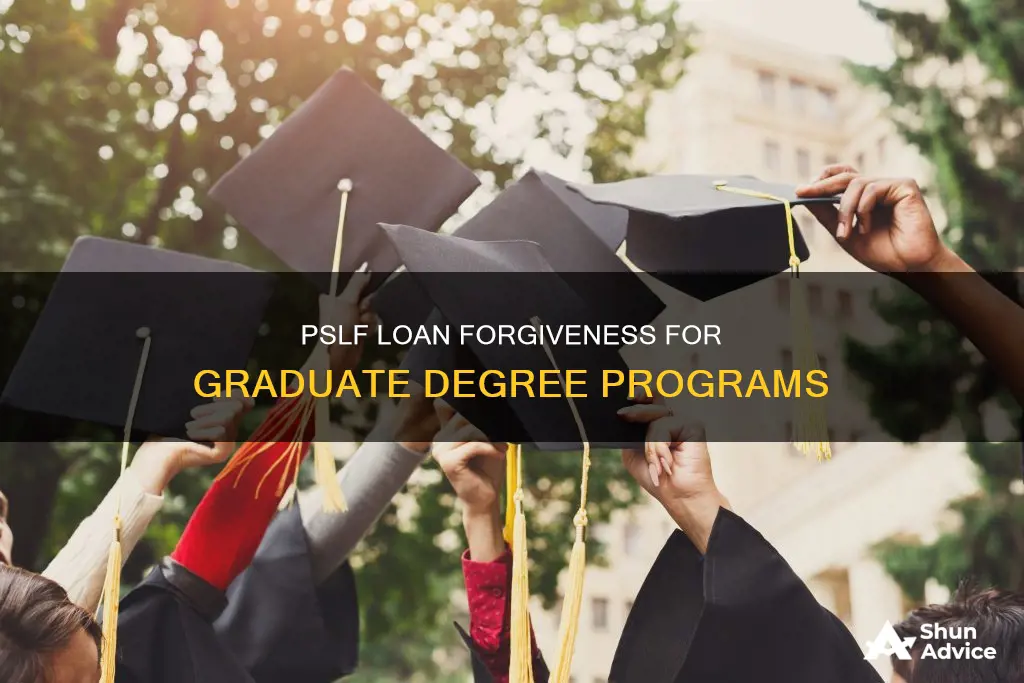
The Public Service Loan Forgiveness (PSLF) program is a federal initiative that forgives federal student loan debt after 10 years of payments (120 payments) while working full-time for a qualifying employer in the nonprofit or government sector. PSLF has strict eligibility requirements and only federal direct loans are eligible, including grad PLUS loans. Borrowers must submit a PSLF certification form annually to maintain their progress toward loan forgiveness. For those considering graduate school, it is important to note that any new loans taken out for this purpose will not be eligible for PSLF until graduation or leaving school, after which a six-month grace period applies before repayment begins.
| Characteristics | Values |
|---|---|
| What is PSLF? | Public Service Loan Forgiveness, a forgiveness program for US federal student loans. |
| Who is eligible for PSLF? | PSLF has strict eligibility requirements. Only federal direct loans are eligible for PSLF. Borrowers must work in a qualifying non-profit or government job. |
| How does PSLF work? | PSLF discharges your remaining federal student loan balance after 10 years (120 payments) of payments while working for the government or a non-profit. Borrowers should be enrolled in an income-driven repayment (IDR) plan. |
| How does PSLF work with graduate degrees? | Any new loans taken out to pay for grad school won't be eligible for PSLF until the borrower graduates or leaves school. After that, there is a six-month grace period before the loans enter repayment and monthly payments start counting toward PSLF. |
| How do I apply for PSLF? | Borrowers should submit a PSLF certification form annually to stay on track for forgiveness. |
What You'll Learn

PSLF for graduate degrees: eligibility
The Public Service Loan Forgiveness (PSLF) program is a federal program that can erase your student loan balance after you make 10 years' worth of monthly payments (120 payments) while working for the government or a nonprofit organization. PSLF is designed to encourage students to enter potentially low-paying but socially valuable careers like firefighting, teaching, government, nursing, public interest law, the military, and religious work.
Only federal direct loans are eligible for PSLF. If you have a Federal Family Education Loan (FFEL) or Perkins loan, you’ll need to convert them into a direct consolidation loan to qualify. Grad PLUS loans are also eligible for PSLF. While working toward PSLF, you should be enrolled in an income-driven repayment (IDR) plan, which uses your family size and income to determine your monthly payment.
If you take out new loans to pay for graduate school, these won't be eligible for PSLF until you graduate or leave school. After that, you’ll have a six-month grace period before repayment starts and your monthly loan payments begin to count toward PSLF. If you make payments on those loans during school, they won't count toward PSLF. These new loans for graduate school will have their own timeline for PSLF and won't be forgiven at the same time as your previous loans.
It's important to be cautious about consolidating undergraduate and graduate loans. Each time you consolidate, any previous PSLF payments are typically reset, and you have to start over. To avoid losing your previous PSLF payments, borrowers are encouraged to file an employer certification form at least once a year and send it to the Department of Education.
PSLF Covers Only Federal Loans, Not Private Ones
You may want to see also

PSLF and career trajectory
The Public Service Loan Forgiveness (PSLF) program is a federal initiative that offers tax-free forgiveness for the entire remaining federal student loan balance for borrowers who pursue careers in public service. This includes careers in the government, non-profit organizations, or schools. To qualify for PSLF, borrowers must make 10 years' worth of payments (120 payments) while working in one of these sectors. This program is designed to encourage students to enter potentially low-paying but socially valuable careers like firefighting, teaching, government, nursing, public interest law, the military, and religious work.
PSLF can impact career trajectories in several ways. Firstly, it provides an incentive for individuals to pursue careers in public service. Knowing that their federal student loans can be forgiven after 10 years of payments and service can motivate people to seek out and remain in these careers. This can be especially attractive for those with substantial student loan debt, as it offers a path to financial relief while also contributing to society.
Secondly, PSLF can influence career trajectories by providing flexibility and opportunities for advancement within the public service sector. For example, an individual with PSLF credit who is already working in a qualifying role may consider returning to school to obtain a graduate degree. This could enhance their career prospects and qualify them for more advanced positions within their field. Obtaining a graduate degree can lead to promotions, salary increases, and specialized roles that may not have been accessible without the additional education.
However, it is important to note that any new loans taken out to finance a graduate degree will have their own timeline for PSLF and will not be forgiven simultaneously as previous loans. These new loans will only be eligible for PSLF once the borrower graduates or leaves graduate school, followed by a six-month grace period. After this grace period, the loans will enter repayment, and the monthly payments will begin to count toward PSLF. Therefore, individuals considering returning to school while participating in PSLF should carefully weigh the benefits against the potential extension of their loan repayment period.
Additionally, borrowers should exercise caution when consolidating undergraduate and graduate loans. While consolidation can simplify loan management, it may also impact the PSLF timeline, particularly if the consolidation includes loans that are not eligible for PSLF. It is crucial to understand the specific rules and requirements of PSLF before making any decisions regarding loan consolidation.
In conclusion, PSLF can shape career trajectories by encouraging individuals to enter and remain in public service careers. It also provides opportunities for advancement within these sectors by supporting continued education. However, borrowers should carefully consider the potential impact on their loan repayment timelines when pursuing additional degrees. Proper planning and understanding of the PSLF program's requirements are essential to maximizing its benefits and achieving one's career goals.
Private Loans: Impacting Your Financial Aid Eligibility?
You may want to see also

PSLF: consolidating undergraduate and graduate loans
The Public Service Loan Forgiveness (PSLF) program is a federal program that can erase your student loan balance after you make 10 years' worth of monthly payments (120 payments) while working full-time for the government or a nonprofit organization. PSLF only applies to federal direct loans, including Grad PLUS loans. If you have a Federal Family Education Loan (FFEL) or Perkins loan, you'll need to convert them into a direct consolidation loan to qualify for PSLF.
Consolidating undergraduate and graduate loans can be done, but it is important to note that consolidating loans will typically reset your PSLF payment count. This means that any previous PSLF payments made on the loans being consolidated will not carry over, and you will have to start the 120 payments over again.
If you are considering consolidating your undergraduate and graduate loans, it is important to carefully consider the potential impact on your PSLF progress. Any new loans you take out to pay for graduate school will not be eligible for PSLF until you graduate or leave school. Once you have graduated or left school, you will have a six-month grace period before the loans enter repayment and your monthly loan payments will start counting toward PSLF.
If you are thinking of going back to graduate school while working towards PSLF, it is important to understand how it will affect your loan payments and PSLF progress. Your loans will automatically go into in-school deferment if you are enrolled at least half-time in an eligible college or career school. This means that you will not need to make payments on your loans while in school, but these months will also not count towards the 120 payments needed for PSLF.
In conclusion, while it is possible to consolidate undergraduate and graduate loans, it is important to carefully consider the impact on your PSLF progress. Any previous PSLF payments on the loans being consolidated will typically be reset, and new loans for graduate school will not be eligible for PSLF until you graduate or leave school.
Private Loan Greenpath: A Smart Financial Move?
You may want to see also

PSLF: repayment plans
The Public Service Loan Forgiveness (PSLF) program is a federal initiative that offers tax-free forgiveness for the entire remaining federal student loan balance for borrowers who have made 10 years' worth of payments while working for the government or a nonprofit organization. PSLF was designed to encourage students to enter potentially low-paying but socially valuable careers, such as teaching, government, nursing, public interest law, the military, and religious work.
To qualify for PSLF, borrowers must make 120 monthly payments while working full-time for a qualifying employer. Payments under PSLF do not have to be consecutive. The program also offers a PSLF Waiver that waives the first and second rules through October 31, 2022. This means that if you have FFEL loans, for example, you can consolidate them into the Direct system, and if you were on a graduated or extended repayment plan rather than an income-driven plan, those payments will count within this window.
It's important to note that borrowers on the standard, extended, or graduated student loan repayment plans won't have those payments count toward PSLF. Instead, to qualify for PSLF, borrowers should be enrolled in an income-driven repayment (IDR) plan. IDR plans determine monthly payments based on family size and income. Additionally, Federal Family Education Loans (FFEL) or Perkins loans must be converted into direct consolidation loans to qualify for PSLF.
For those considering returning to school, it's important to understand how this decision may impact your PSLF progress. Any new loans taken out to pay for graduate school won't be eligible for PSLF until you graduate or leave school. After that, a six-month grace period will be provided before the loans enter repayment and monthly payments start counting toward PSLF. These new loans for graduate school will have their own timeline for PSLF and won't be forgiven at the same time as previous loans.
Prosper Loan Income Verification: What You Need to Know
You may want to see also

PSLF: qualifying payments
The Public Service Loan Forgiveness (PSLF) program is a federal initiative that offers tax-free forgiveness for the entire remaining federal student loan balance. This is applicable for those who have worked for a school, nonprofit, or government organisation for a minimum of 10 years while making qualifying student loan payments. PSLF has a specific set of criteria for qualifying payments.
Firstly, borrowers must be enrolled in an income-driven repayment (IDR) plan. This plan calculates monthly payments based on family size and income. It is important to note that payments made under standard, extended, or graduated student loan repayment plans do not count toward PSLF. To maximise the benefits of the IDR plan, borrowers should submit a PSLF certification form annually to ensure they stay on track for forgiveness.
Secondly, PSLF qualifying payments are only applicable after graduation or leaving school. Any new loans taken out to fund graduate studies will have their own timeline for PSLF and will not be forgiven simultaneously with previous loans. There is a six-month grace period after completing or exiting a graduate program before the new loans enter repayment and monthly payments begin to count toward PSLF.
Additionally, borrowers with Federal Family Education Loans (FFEL) or Perkins loans must convert them into direct consolidation loans to qualify for PSLF. Consolidating undergraduate and graduate loans should be done with caution, as it may impact the overall timeline for loan forgiveness.
It is worth noting that the PSLF Waiver, which was active until October 31, 2022, waived certain rules. During this period, borrowers with FFEL loans could consolidate their loans into the Direct system, and payments made under graduated or extended repayment plans were considered qualifying payments.
Prime Lending: Selling Loans and Mortgage Deals
You may want to see also
Frequently asked questions
Only federal direct loans are eligible for PSLF. Grad PLUS loans are eligible for PSLF. However, any new loans you take out for a graduate degree won't be eligible for PSLF until you graduate or leave school. After that, you will have a six-month grace period before repayment begins and your monthly loan payments start counting toward PSLF.
PSLF is a federal program that can erase your student loan balance after you make 10 years' worth of monthly payments (120 payments) while working for the government or a nonprofit organization.
To qualify for PSLF, you must have federal direct loans, work in a qualifying nonprofit or government job, and submit a PSLF certification form annually. You should also be on an income-driven repayment (IDR) plan.
You can consolidate undergraduate and graduate loans, but doing so will typically wipe clean any previous PSLF payments, forcing you to start over.







